warning SKODA SUPERB 2003 1.G / (B5/3U) Owner's Manual
[x] Cancel search | Manufacturer: SKODA, Model Year: 2003, Model line: SUPERB, Model: SKODA SUPERB 2003 1.G / (B5/3U)Pages: 259
Page 168 of 259
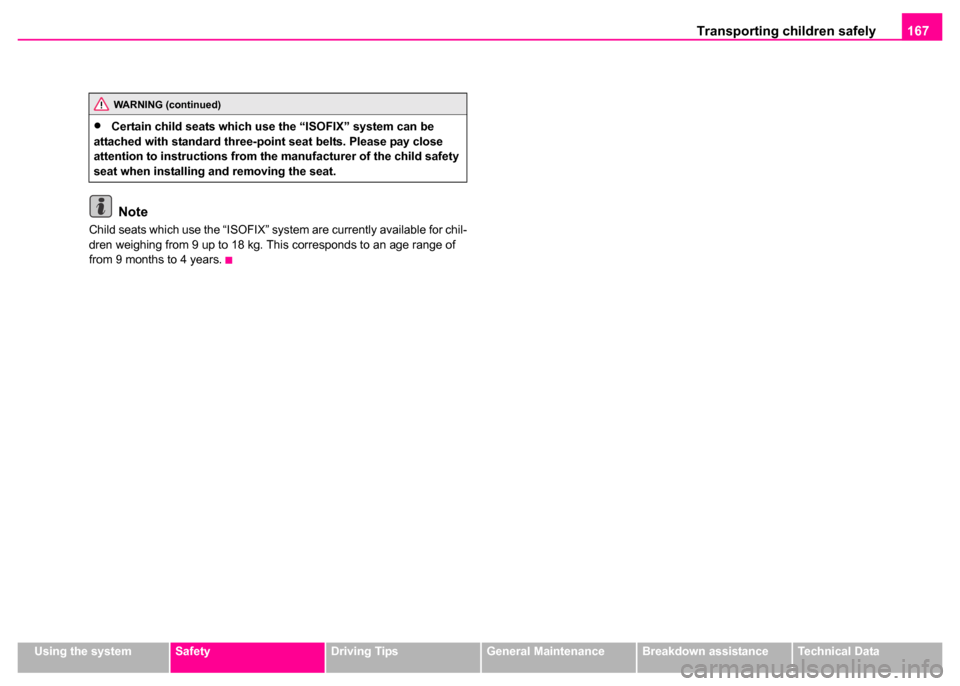
Transporting children safely 167
Using the systemSafetyDriving TipsGeneral MaintenanceBreakdown assistanceTechnical Data
Note
Child seats which use the “ISOFIX” system are currently available for chil-
dren weighing from 9 up to 18 kg. This corresponds to an age range of
from 9 months to 4 years.
WARNING (continued)
•Certain child seats which use the “ISOFIX” system can be
attached with standard three-point seat belts. Please pay close
attention to instructions from the manufacturer of the child safety
seat when installing and removing the seat.
Page 171 of 259
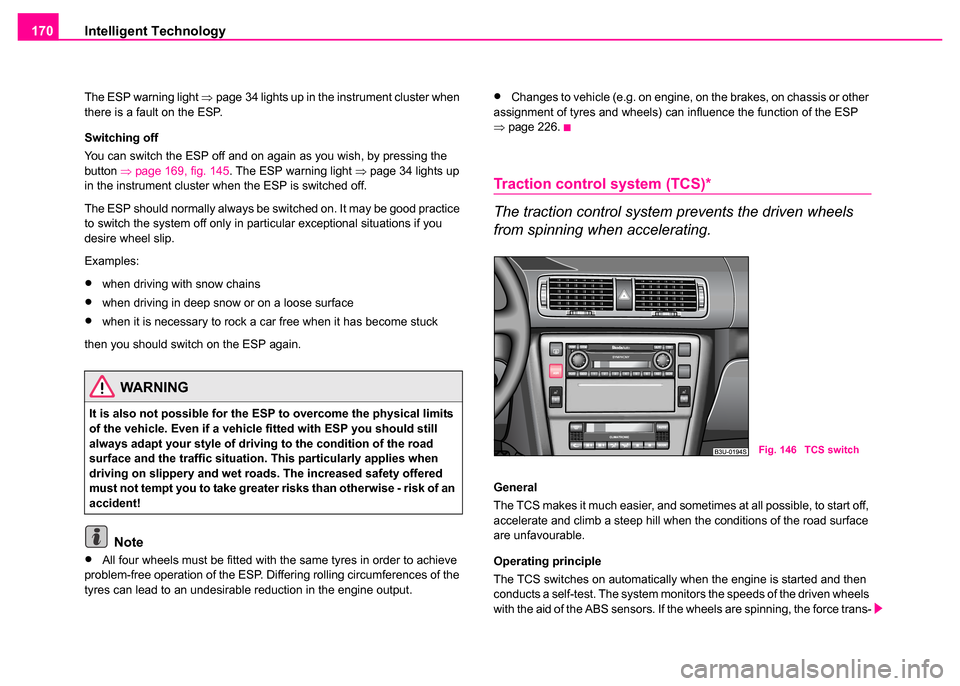
Intelligent Technology
170
The ESP warning light ⇒page 34 lights up in the instrument cluster when
there is a fault on the ESP.
Switching off
You can switch the ESP off and on again as you wish, by pressing the
button ⇒page 169, fig. 145 . The ESP warning light ⇒page 34 lights up
in the instrument cluster when the ESP is switched off.
The ESP should normally always be switched on. It may be good practice
to switch the system off only in particular exceptional situations if you
desire wheel slip.
Examples:
•when driving with snow chains
•when driving in deep snow or on a loose surface
•when it is necessary to rock a car free when it has become stuck
then you should switch on the ESP again.
Note
•All four wheels must be fitted with the same tyres in order to achieve
problem-free operation of the ESP. Differing rolling circumferences of the
tyres can lead to an undesirable reduction in the engine output.
•Changes to vehicle (e.g. on engine, on the brakes, on chassis or other
assignment of tyres and wheels) can influence the function of the ESP
⇒ page 226.
Traction control system (TCS)*
The traction control system prevents the driven wheels
from spinning when accelerating.
General
The TCS makes it much easier, and sometimes at all possible, to start off,
accelerate and climb a steep hill when the conditions of the road surface
are unfavourable.
Operating principle
The TCS switches on automatically when the engine is started and then
conducts a self-test. The system monitors the speeds of the driven wheels
with the aid of the ABS sensors. If the wheels are spinning, the force trans-
WARNING
It is also not possible for the ESP to overcome the physical limits
of the vehicle. Even if a vehicle fitted with ESP you should still
always adapt your style of driving to the condition of the road
surface and the traffic situation. This particularly applies when
driving on slippery and wet roads. The increased safety offered
must not tempt you to take greater risks than otherwise - risk of an
accident!
Fig. 146 TCS switch
Page 172 of 259
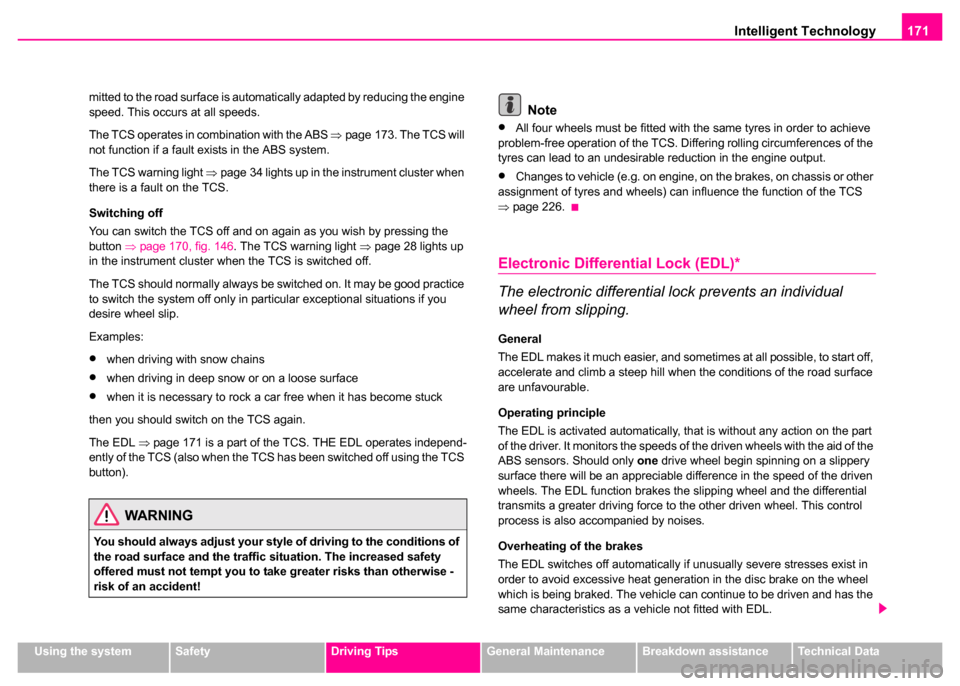
Intelligent Technology171
Using the systemSafetyDriving TipsGeneral MaintenanceBreakdown assistanceTechnical Data
mitted to the road surface is automatically adapted by reducing the engine
speed. This occurs at all speeds.
The TCS operates in combination with the ABS
⇒page 173. The TCS will
not function if a fault exists in the ABS system.
The TCS warning light ⇒page 34 lights up in the instrument cluster when
there is a fault on the TCS.
Switching off
You can switch the TCS off and on again as you wish by pressing the
button ⇒page 170, fig. 146 . The TCS warning light ⇒page 28 lights up
in the instrument cluster when the TCS is switched off.
The TCS should normally always be switched on. It may be good practice
to switch the system off only in particular exceptional situations if you
desire wheel slip.
Examples:
•when driving with snow chains
•when driving in deep snow or on a loose surface
•when it is necessary to rock a car free when it has become stuck
then you should switch on the TCS again.
The EDL ⇒page 171 is a part of the TCS. THE EDL operates independ-
ently of the TCS (also when the TCS has been switched off using the TCS
button).
Note
•All four wheels must be fitted with the same tyres in order to achieve
problem-free operation of the TCS. Differing rolling circumferences of the
tyres can lead to an undesirable reduction in the engine output.
•Changes to vehicle (e.g. on engine, on the brakes, on chassis or other
assignment of tyres and wheels) can influence the function of the TCS
⇒ page 226.
Electronic Differential Lock (EDL)*
The electronic differential lock prevents an individual
wheel from slipping.
General
The EDL makes it much easier, and sometimes at all possible, to start off,
accelerate and climb a steep hill when the conditions of the road surface
are unfavourable.
Operating principle
The EDL is activated automatically, that is without any action on the part
of the driver. It monitors the speeds of the driven wheels with the aid of the
ABS sensors. Should only one drive wheel begin spinning on a slippery
surface there will be an appreciable difference in the speed of the driven
wheels. The EDL function brakes the slipping wheel and the differential
transmits a greater driving force to the other driven wheel. This control
process is also accompanied by noises.
Overheating of the brakes
The EDL switches off automatically if unusually severe stresses exist in
order to avoid excessive heat generation in the disc brake on the wheel
which is being braked. The vehicle can continue to be driven and has the
same characteristics as a vehicle not fitted with EDL.
WARNING
You should always adjust your style of driving to the conditions of
the road surface and the traffic situation. The increased safety
offered must not tempt you to take greater risks than otherwise -
risk of an accident!
Page 173 of 259
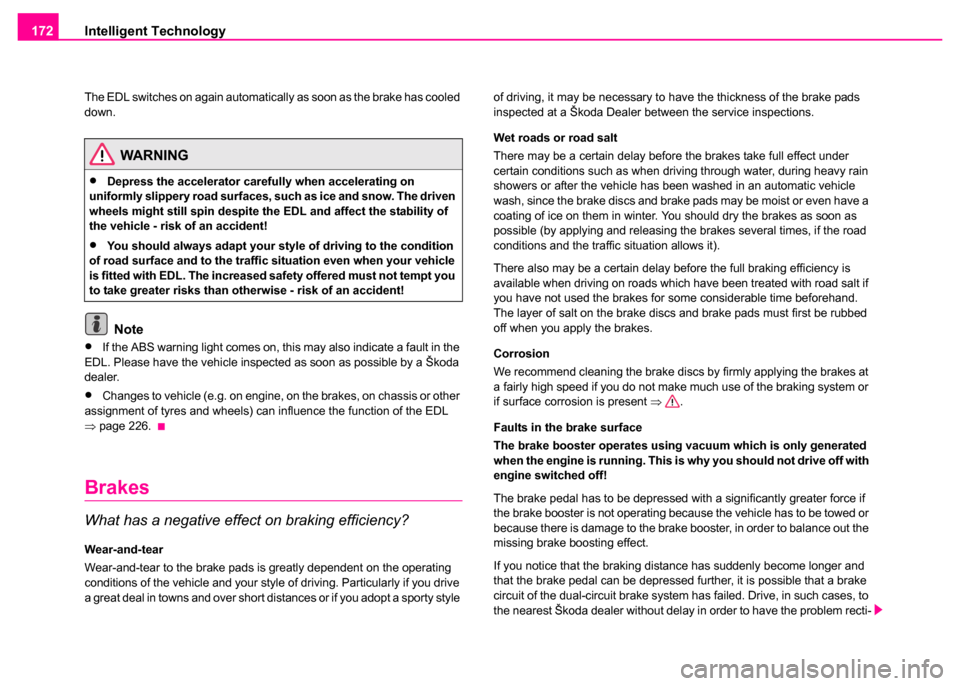
Intelligent Technology
172
The EDL switches on again automatically as soon as the brake has cooled
down.
Note
•If the ABS warning light comes on, this may also indicate a fault in the
EDL. Please have the vehicle inspected as soon as possible by a Škoda
dealer.
•Changes to vehicle (e.g. on engine, on the brakes, on chassis or other
assignment of tyres and wheels) can influence the function of the EDL
⇒ page 226.
Brakes
What has a negative effect on braking efficiency?
Wear-and-tear
Wear-and-tear to the brake pads is greatly dependent on the operating
conditions of the vehicle and your style of driving. Particularly if you drive
a great deal in towns and over short distances or if you adopt a sporty style of driving, it may be necessary to have the thickness of the brake pads
inspected at a Škoda Dealer between the service inspections.
Wet roads or road salt
There may be a certain delay before the brakes take full effect under
certain conditions such as when driving through water, during heavy rain
showers or after the vehicle has been washed in an automatic vehicle
wash, since the brake discs and brake pads may be moist or even have a
coating of ice on them in winter. You should dry the brakes as soon as
possible (by applying and releasing the brakes several times, if the road
conditions and the traffic situation allows it).
There also may be a certain delay before the full braking efficiency is
available when driving on roads which have been treated with road salt if
you have not used the brakes for some considerable time beforehand.
The layer of salt on the brake discs and brake pads must first be rubbed
off when you apply the brakes.
Corrosion
We recommend cleaning the brake discs by firmly applying the brakes at
a fairly high speed if you do not make much use of the braking system or
if surface corrosion is present
⇒.
Faults in the brake surface
The brake booster operates using vacuum which is only generated
when the engine is running. This is why you should not drive off with
engine switched off!
The brake pedal has to be depressed with a significantly greater force if
the brake booster is not operating because the vehicle has to be towed or
because there is damage to the brake booster, in order to balance out the
missing brake boosting effect.
If you notice that the braking distance has suddenly become longer and
that the brake pedal can be depressed further, it is possible that a brake
circuit of the dual-circuit brake system has failed. Drive, in such cases, to
the nearest Škoda dealer without delay in order to have the problem recti-
WARNING
•Depress the accelerator carefully when accelerating on
uniformly slippery road surfaces, such as ice and snow. The driven
wheels might still spin despite the EDL and affect the stability of
the vehicle - risk of an accident!
•You should always adapt your style of driving to the condition
of road surface and to the traffic situation even when your vehicle
is fitted with EDL. The increased safety offered must not tempt you
to take greater risks than otherwise - risk of an accident!
Page 174 of 259

Intelligent Technology173
Using the systemSafetyDriving TipsGeneral MaintenanceBreakdown assistanceTechnical Data
fied. Drive at a reduced speed while on your way to the dealer and adapt
your style of driving to the higher brake pedal pressure required.
Low brake fluid level
An insufficient level of brake fluid may result in problems in the brake
system. The level of the brake fluid is monitored electronically
⇒page 35.
Caution
•Never allow the brakes to rub by applying slight pressure if you do not
wish to brake the vehicle. This causes the brakes to overheat and can also
result in a longer braking distance and excessive wear.
•Before negotiating a steep downhill section, please reduce your
speed, shift down into the next lower gear (manual gearbox) or select a
lower driving stage (automatic gearbox). This enables you to make full use
of the braking power of the vehicle and reduces the strain on the brakes.
Any additional braking should be done intermittently, not continuously.
Antiblock brake system (ABS)
ABS prevents the wheels locking when braking.
General
The ABS contributes significantly to enhancing the active safety of your
vehicle. Compared to a car not fitted with the ABS brake system, you are
able to retain optimal steering ability even during a full brake application
on a slippery road surface because the wheels do not lock up.
You must not expect, however, that the braking distance will be shorter
under all circumstances as a result of the ABS The braking distance for
example on gravel and fresh snow, when you should anyway be driving
slowly and cautiously, will be longer.
Operating principle
As soon as the vehicle speed has increased to about 6 km/hour an auto-
matic test procedure is conducted during which you will be able to hear a
pumping noise for about 1 second.
The brake pressure will be reduced on a wheel which is rotating at a speed
which is too low for the speed of the vehicle and tending to lock. This
control cycle is noticeable from a pulsating movement of the brake
pedal which is accompanied by noises. This is consciously intended to
provide the driver with the information that the wheels are tending to lock
(ABS control range). You must always keep the brake pedal depressed to
enable the ABS to optimally control the brake application in this braking
range. Never interrupt the application of the brakes!
WARNING
•Only apply the brakes for the purpose of drying and cleaning
the brake discs if the traffic conditions permit this. Do not place
any other road users in jeopardy.
•When retrospectively mounting a front spoiler, solid wheel
hubs etc. one must ensure that the air supply to the front wheel
brakes is not reduced otherwise the braking system could run too
hot.
•Allow for the fact that new brake pads do not achieve their full
braking efficiency until approximately 200 kilometres. New brake
pads must be first “run in” before they develop their optimal fric-
tion force. You can, however, compensate for this slightly reduced
braking force by increasing the pressure on the brake pedal. This
guideline also applies to any new brake pads installed at a future
date.
Page 175 of 259
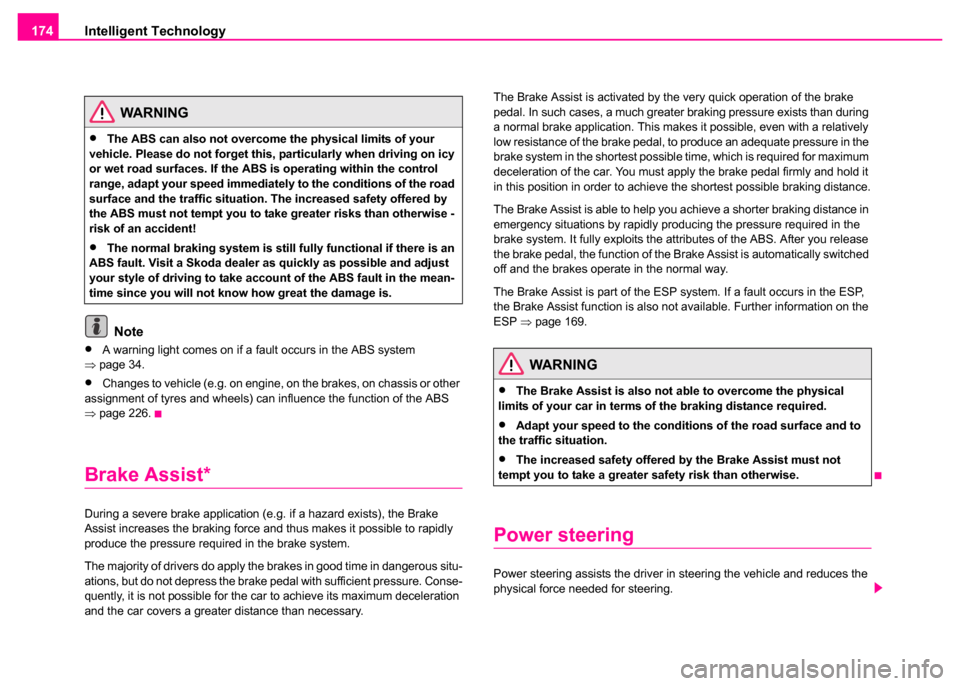
Intelligent Technology
174
Note
•A warning light comes on if a fault occurs in the ABS system
⇒ page 34.
•Changes to vehicle (e.g. on engine, on the brakes, on chassis or other
assignment of tyres and wheels) can influence the function of the ABS
⇒ page 226.
Brake Assist*
During a severe brake application (e.g. if a hazard exists), the Brake
Assist increases the braking force and thus makes it possible to rapidly
produce the pressure required in the brake system.
The majority of drivers do apply the brakes in good time in dangerous situ-
ations, but do not depress the brake pedal with sufficient pressure. Conse-
quently, it is not possible for the car to achieve its maximum deceleration
and the car covers a greater distance than necessary. The Brake Assist is activated by the very quick operation of the brake
pedal. In such cases, a much greater braking pressure exists than during
a normal brake application. This makes it possible, even with a relatively
low resistance of the brake pedal, to produce an adequate pressure in the
brake system in the shortest possible time, which is required for maximum
deceleration of the car. You must apply the brake pedal firmly and hold it
in this position in order to achieve the shortest possible braking distance.
The Brake Assist is able to help you achieve a shorter braking distance in
emergency situations by rapidly producing the pressure required in the
brake system. It fully exploits the attributes of the ABS. After you release
the brake pedal, the function of the Brake Assist is automatically switched
off and the brakes operate in the normal way.
The Brake Assist is part of the ESP system. If a fault occurs in the ESP,
the Brake Assist function is also not available. Further information on the
ESP
⇒page 169.
Power steering
Power steering assists the driver in steering the vehicle and reduces the
physical force needed for steering.
WARNING
•The ABS can also not overcome the physical limits of your
vehicle. Please do not forget this, particularly when driving on icy
or wet road surfaces. If the ABS is operating within the control
range, adapt your speed immediately to the conditions of the road
surface and the traffic situation. The increased safety offered by
the ABS must not tempt you to take greater risks than otherwise -
risk of an accident!
•The normal braking system is still fully functional if there is an
ABS fault. Visit a Skoda dealer as quickly as possible and adjust
your style of driving to take account of the ABS fault in the mean-
time since you will not know how great the damage is.
WARNING
•The Brake Assist is also not able to overcome the physical
limits of your car in terms of the braking distance required.
•Adapt your speed to the conditions of the road surface and to
the traffic situation.
•The increased safety offered by the Brake Assist must not
tempt you to take a greater safety risk than otherwise.
Page 178 of 259

Driving and the Environment177
Using the systemSafetyDriving TipsGeneral MaintenanceBreakdown assistanceTechnical Data
New brake pads
Allow for the fact that new brake pads do not achieve their full braking effi-
ciency until after the first 200 kilometres. New brake pads must be first
“run in” before they develop their optimal friction force. You can, however,
compensate for this slightly reduced braking force by increasing the pres-
sure on the brake pedal.
This guideline also applies to any new brake pads installed at a future
date.
During the running-in period, you should avoid excessive stresses on the
brakes. This includes, for example, violent braking, particularly from very
high speeds, and also when crossing mountain passes.
Catalytic converter
Proper operation of the emission control system (catalytic
converter) is of major significance for driving your vehicle
in an environmentally conscious way.
Please refer to the following guidelines:
– Always fill the fuel tank with unleaded petrol ⇒page 198,
“Grades of petrol”.
– Never run the fuel tank completely empty.
– Do not switch off the ignition while you are driving the vehicle.
– Do not pour too much oil into the engine ⇒page 207,
“Replenishing engine oil”. – Do not tow-start the vehicle over a distance of more than 50
metres ⇒page 239, “Tow-starting a vehicle”.
If you drive your vehicle in a country in which unleaded petrol is not avail-
able, you must have the catalytic converter replaced later when driving the
vehicle into a country in which use of a catalytic converter is mandatory.
Caution
•Vehicles fitted with catalytic converter should never be allowed to let
the fuel tank to run completely empty. An irregular fuel supply can result
in poor ignition or misfiring. Unburnt fuel may get into the exhaust system
and damage the catalytic converter.
•Filling the tank even only once with leaded petrol will result in the cata-
lytic converter being destroyed.
•If you detect misfiring, a drop in performance or irregular engine
running when driving, reduce your speed immediately and have the
vehicle inspected by the nearest Škoda dealer. The symptoms described
may be caused by a fault in the ignition system. Unburnt fuel may get into
the exhaust system and damage the catalytic converter.
WARNING
•In view of the high temperatures which may be produced in the
catalytic converter, one should always park a vehicle in such a way
that the catalytic converter cannot come into contact with easily
flammable materials below the vehicle - a risk of fire!
•Never use additional underbody protection or corrosion-
protection agents for the exhaust pipes, catalytic converters or
heat shields. Such substances might ignite when driving - risk of
fire!
Page 185 of 259
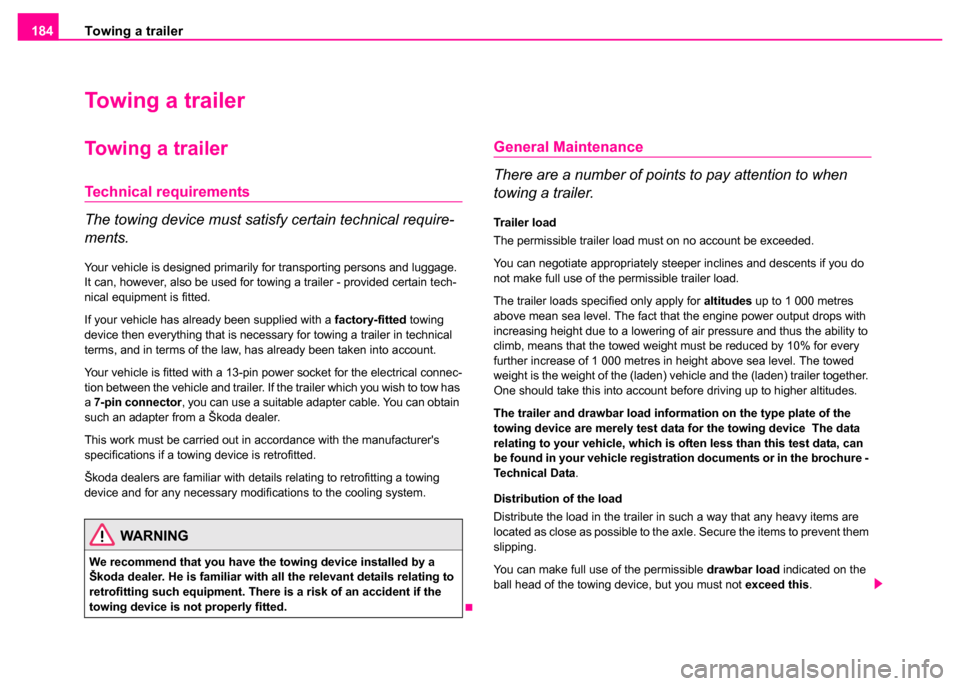
Towing a trailer
184
Towing a trailer
Towing a trailer
Technical requirements
The towing device must satisfy certain technical require-
ments.
Your vehicle is designed primarily for transporting persons and luggage.
It can, however, also be used for towing a trailer - provided certain tech-
nical equipment is fitted.
If your vehicle has already been supplied with a factory-fitted towing
device then everything that is necessary for towing a trailer in technical
terms, and in terms of the law, has already been taken into account.
Your vehicle is fitted with a 13-pin power socket for the electrical connec-
tion between the vehicle and trailer. If the trailer which you wish to tow has
a 7-pin connector , you can use a suitable adapter cable. You can obtain
such an adapter from a Škoda dealer.
This work must be carried out in accordance with the manufacturer's
specifications if a towing device is retrofitted.
Škoda dealers are familiar with details relating to retrofitting a towing
device and for any necessary modifications to the cooling system.
General Maintenance
There are a number of points to pay attention to when
towing a trailer.
Trailer load
The permissible trailer load must on no account be exceeded.
You can negotiate appropriately steeper inclines and descents if you do
not make full use of the permissible trailer load.
The trailer loads specified only apply for altitudes up to 1 000 metres
above mean sea level. The fact that the engine power output drops with
increasing height due to a lowering of air pressure and thus the ability to
climb, means that the towed weight must be reduced by 10% for every
further increase of 1 000 metres in height above sea level. The towed
weight is the weight of the (laden) vehicle and the (laden) trailer together.
One should take this into account before driving up to higher altitudes.
The trailer and drawbar load information on the type plate of the
towing device are merely test data for the towing device The data
relating to your vehicle, which is often less than this test data, can
be found in your vehicle registration documents or in the brochure -
Technical Data.
Distribution of the load
Distribute the load in the trailer in such a way that any heavy items are
located as close as possible to the axle. Secure the items to prevent them
slipping.
You can make full use of the permissible drawbar load indicated on the
ball head of the towing device, but you must not exceed this.
WARNING
We recommend that you have the towing device installed by a
Škoda dealer. He is familiar with all the relevant details relating to
retrofitting such equipment. There is a risk of an accident if the
towing device is not properly fitted.
Page 187 of 259
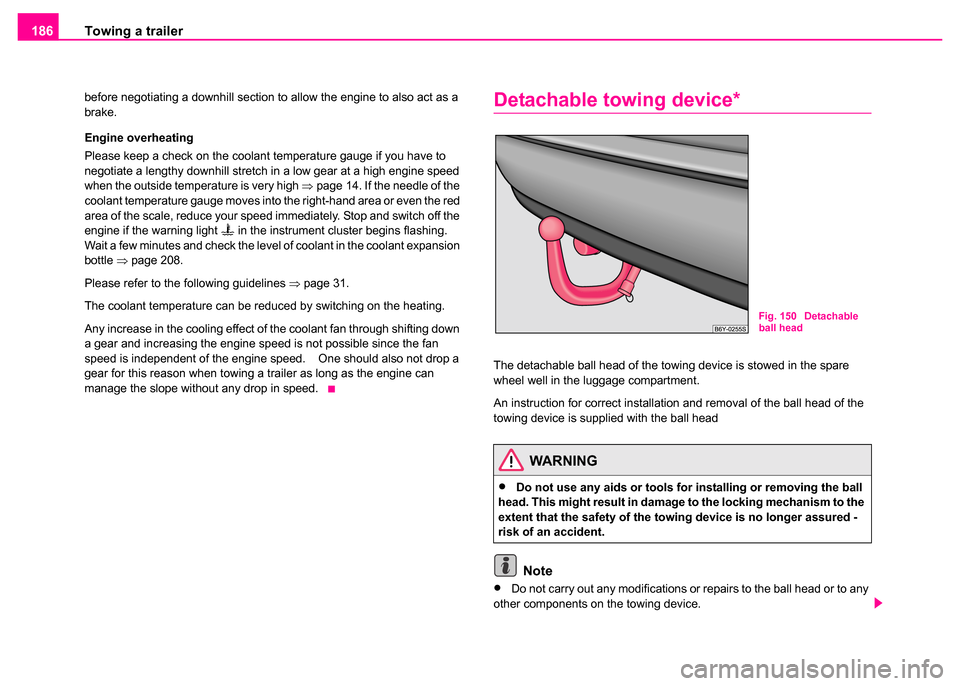
Towing a trailer
186
before negotiating a downhill section to allow the engine to also act as a
brake.
Engine overheating
Please keep a check on the coolant temperature gauge if you have to
negotiate a lengthy downhill stretch in a low gear at a high engine speed
when the outside temperature is very high ⇒page 14. If the needle of the
coolant temperature gauge moves into the right-hand area or even the red
area of the scale, reduce your speed immediately. Stop and switch off the
engine if the warning light
in the instrument cluster begins flashing.
Wait a few minutes and check the level of coolant in the coolant expansion
bottle ⇒page 208.
Please refer to the following guidelines ⇒page 31.
The coolant temperature can be reduced by switching on the heating.
Any increase in the cooling effect of the coolant fan through shifting down
a gear and increasing the engine speed is not possible since the fan
speed is independent of the engine speed. One should also not drop a
gear for this reason when towing a trailer as long as the engine can
manage the slope without any drop in speed.
Detachable towing device*
The detachable ball head of the towing device is stowed in the spare
wheel well in the luggage compartment.
An instruction for correct installation and removal of the ball head of the
towing device is supplied with the ball head
Note
•Do not carry out any modifications or repairs to the ball head or to any
other components on the towing device.
WARNING
•Do not use any aids or tools for installing or removing the ball
head. This might result in damage to the locking mechanism to the
extent that the safety of the towing device is no longer assured -
risk of an accident.
Fig. 150 Detachable
ball head
Page 190 of 259

Care and cleaning189
Using the systemSafetyDriving TipsGeneral MaintenanceBreakdown assistanceTechnical Data
General Maintenance
Care and cleaning
General
Proper care retains the value of your vehicle.
Regular and proper care retains the value of your vehicle. It may also be
one of the requirements for the acceptance of warranty claims relating to
corrosion damage and paint defects on the bodywork.
You can obtain the necessary care products from Škoda dealers. Please
follow the instructions for use on the package.
For the sake of the environment
•Always select environmentally-friendly products when purchasing
vehicle care products.
•Do not dispose of residues of care products in domestic waste.
Care of the exterior of vehicle
Washing the vehicle
Frequent washing protects your vehicle.
The best protection for your vehicle against harmful environmental influ-
ences is frequent washing and wax treatment. How often you should
wash your vehicle depends on a wide range of factors, such as:
•Frequency of use
•The parking situation (garage, below trees etc.)
•Season of the year
•Weather conditions
•Environmental influences
The longer insect residues, bird droppings, tree sap, road and industrial
dust, tar, soot particles, road salt and other aggressive deposits remain
adhering to the paintwork of your vehicle, the more detrimental their
destructive effect can be. High temperatures, such as those caused by
intensive sun's rays, accentuate this caustic effect.
It may therefore be necessary, in certain circumstances, to wash the car
once a week. It may also be sufficient, however, to wash the car once a
month followed by appropriate wax treatment.
It is essential to also thoroughly wash the underside of your vehicle at
the end of the winter road salting and gritting period.
WARNING
•Care products may be harmful to your health if not used
according to the instructions.
•Always store care products in a safe place, out of the reach of
children - risk of poisoning!